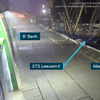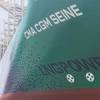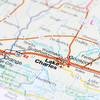Sea Jet Tests Advanced Water Propulsion
By Naval Surface Warfare Center Carderock Division Corporate Communications
The new Advanced Electric Ship Demonstrator (AESD) is expected to participate in trials on Lake Pend Oreille at the Carderock Division's Acoustic Research Detachment (ARD), Bayview, Idaho in mid-November. Recently christened Sea Jet, the 133-foot test platform houses a Rolls Royce Naval Marine advanced waterjet propulsion system, the AWJ-21, to improve surface ship efficiency and maneuverability by reducing noise and wake.
Capt. Charles Behrle, Commander of the Carderock Division, says his organization is truly gratified to be part of a major technological leap that the AESD brings to the U.S. Navy. He noted, "Having the AESD at the ARD in Bayview marks a new era for the work force in applying their submarine expertise to the Navy's surface ships."
The AESD resembles an early DD (X) design. The steel platform displacement is about 120 tons. It was built by Dakota Creek Industries, Inc. (DCI), Anacortes, Washington. A diesel generator powers two electric propulsion motors shafted to two waterjet pumps which are integrated with the hull below the waterline, with a 720-cell battery bank powering the motors for acoustic trials, eliminating the diesels as a noise source for quiet operations and high-speed tests. The AESD will have a crew of six and achieve top speeds of 8 knots on diesel, 16 knots battery power.
Carderock's Large Cavitation Channel in Memphis is the site of hydrodynamic investigations. The team will use a ½-scale mockup of the ¼-scale AESD, establishing AWJ-21 data, verifying propulsion characteristics and cavitation performance.
The hull sections were shipped and assembled at ARD's Model Engineering and Support Facility. Builder's trials and acceptance trials are scheduled, after which the Navy is planned to accept Sea Jet, with test work until March. Then another electric-drive propulsion system, RimJet, a pod on struts below the waterline, will be installed. Developed by Electric Boat, it eliminates shafting from within the hull. Researchers will remove the stern and add a RimJet aft section.
Other modifications include removing the aluminum deckhouse and installing a low-signature composite version for investigating radar signatures. The Office of Naval Research funded a high-resolution measurement array to collect data for quiet surface ship noise investigations, so the array's accuracy will be verified as well. A multi-year plan for Sea Jet is being developed.
The Navy is building on the years of knowledge and world class facilities used in testing model submarines and applying that knowledge to reduce the signatures of surface ships. The operations in shallow water and presence of low cost mines create a need to understand the acoustic and electro-magnetic signature generation and then ways to mitigate the effects. For the sponsors, this is a cost effective way to leverage the technology already in place for submarine testing. For the ARD it enables us to maintain the unique capabilities we have and apply them to benefit the Navy.






